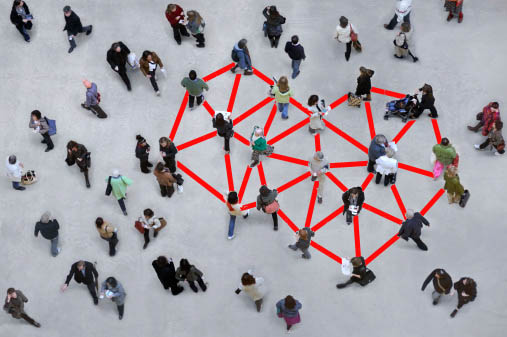When you’re engaged in the messy, non-linear work of systems change, the very structure of your team and organization is a critical key that can either unlock radical change or keep you mired in the status quo.
Hierarchy excels when order and control are necessary to achieve a specific purpose, like coordinating firefighters in a blaze or producing blood cells in our bodies. There are many situations where hierarchy is a wonderful and appropriate tool to create safe, consistent results.
However, in situations where things are rapidly changing and complexifying (hello, pandemic!) hierarchy can become considerably less wonderful.
When you need innovation, adaptability and transformation, you want less order and control, and more emergence.
In these situations, the misuse of hierarchy dramatically slows down our change efforts, at best; at worst, it actively holds a dysfunctional status quo in place and squelches change.
If you are working to innovate your system, it’s likely that the misuse of hierarchy is in some way preventing you from fulfilling your visions of a better world… like riding an elephant in a horse race, and wondering why are we moving so slowly?!

When you recognize that one of the root causes holding back your changework is your inability to adapt by using different organizational structures, you can make sense of your work through a whole new lens, and begin seeking new ways to interact and organize.
Luckily, a template exists for how to create teams and organizations that are creating emergent space for the sake of co-creating new things. They’re called ensembles.
An ensemble is a group that co-creates an emergent future together inspired by their shared purpose – vulnerably, daringly, and with gusto.
You have likely witnessed or participated in one: a dance ensemble, theater production, pick up soccer game, or even working together to make an inspired family meal. Powerful ensembles don’t necessarily operate without hierarchy, they just know how to use it in a more flexible and situationally-appropriate way.
In my work helping changemakers build ensembles, I’ve noticed some common signs that show up when hierarchy is being misused. See if you recognize them below. If you do, you might want to start your journey to becoming an ensemble whisperer: a changemaker who shares power, connects vulnerably, and creates emergent space in service of reinventing the world.
1. Burnout
There’s often an implicit expectation in hierarchical cultures to overwork and sacrifice personal well-being in service of the system. To create caring, nourishing systems, you need people building them who know deep in their bones how to care and nourish, starting with themselves and their team. Hierarchical cultures that lack vulnerability, clear boundaries, and playfulness result in burned out people!
2. Isolation
The stratified nature of hierarchy leaves many feeling disconnected and distant, both from each other and their deep calling to help the world. Hierarchical cultures often value conformity over daring authenticity. Your culture is holding you back if you or others feel like you can’t contribute with your full, quirky, creative self.
3. Frustration Abounds a.k.a. “Can I just vent for a second!?”
In the absence of a connected, caring team, folks often spend a lot of time and energy complaining and venting about interpersonal dynamics and feelings of being disempowered by those “above” them in the hierarchy. If you find yourself venting or holding space for frustrated colleagues often, hierarchy may be creating a distracting amount of noise on your team.
4. Complexity Overwhelm
No matter how smart or insightful you are, one person can only grok so much about a complex system. Because you’re burned out, isolated, and focused on urgent day-to-day needs, your bandwidth for big picture thinking is probably miniscule. You lack a shared awareness of the nature of your system, and don’t know how to cultivate the clarity needed to intervene successfully. If you don’t have a shared practice of actively making sense of emergent patterns together, you are missing opportunities to fulfill your team’s purpose.
5. Disembodiment & Intellectualization
You and your colleagues care deeply about the work you do… but your culture prevents you from sharing it openly. To be “appropriate,” you leave your deep heart at home so you can speak professionally but dispassionately about the people and systems you work in. When was the last time you moved or played with your teammates, or shared your trembling care for the world with them?
6. Over-thinking & Under-Experimenting
You spend lots of time thinking and talking about potential change. Large scale plans are made based on months of meetings but very little prototyping and feedback. If action arises mostly out of meetings, planning sessions and top-down missives, there’s a whole lot of thinking about change and not enough experimentation.
7. Top Heavy a.k.a. “We need more money…”
Last but not least, the phrase I hear most often from changemakers working within hierarchical institutions: “If only we could secure more money, or be granted permission, then we could really make the radical changes we envision.” Hierarchy concentrates power at the top, where money, time and other resources are controlled. Decisions come from those most removed from the day-to-day operations, while those at the ‘bottom’ or front lines have very little power to respond and adapt to emerging needs. Your gut instincts are correct: you need more flow in your system; but what you might need most are ensembles that get the human resources of creativity and care flowing so that the other resources of money and time flow in ways that fuel your vision.
Our dependency on hierarchy has greatly contributed to the dysfunctional state of our systems, and continues to hold back our changework. Reprogramming yourself and your teams with the ensemble mindset at this moment in time has huge, game-changing ramifications for how we co-create the future together. The more we unleash our collective care and creativity through the proliferation of ensembles, the more we will meet the opportunity of this moment for radical, life-giving change.
If this resonates with you, sign up for the Mobius Method newsletter below to receive more pieces like this and updates on our future programming.
If you’re ready to build powerful ensembles that make bold, systems-changing moves together, join the waitlist for our Bold Moves Course and we’ll let you know when we open registration for our next cohort:
Stay in Touch
Join Our Newsletter
Writings, learning opportunities, and more, straight to your inbox.
Learn With Mobius
An online program for changemakers ready to unleash the full capacity of your team.
Follow Us
Stay connected with us and engage with our community of systems changemakers online.


